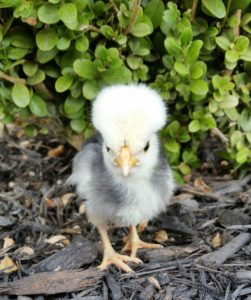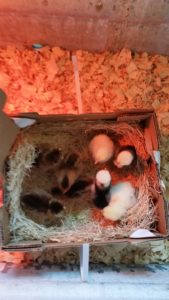by Lori Leigh

We are so excited! Some baby chicks have arrived at LL Farm! Because we don’t have a rooster (or a broody hen to put fertile eggs under), we are raising baby chicks in a brooder again. Isn’t it amazing how things have changed over the last century or so? There are many ways to get baby chicks and you can even specify male or female. I ordered four different breeds, two of each kind, all female, on-line!

The post office called to say that our baby chicks arrived, and were ready to be picked up. Upon entering the building, I could hear them chirping. “I’m coming babies,” I said in my head as I grinned from ear to ear. It brought back memories of getting our first flock of chickens.

Raising baby chicks is kind of like having children…the first go ’round, you do everything by the book, and by the second time (and more), you are a little more relaxed because you have learned a few things along the way. It’s still good to have a reference to go by though, don’t you think? Throughout this article, you can click on the orange highlighted text to read more about a subject.
First off, a brooder is needed if you are going to raise baby chickens. A brooder light, food/water containers, and bedding are also needed. You’ll also need a designated area to keep the brooder. Like I said, you learn along the way…we are using a water trough this time, and wow is it better than what we used before…more room, less clean up, and easier to attach the brooder light. I am also keeping them in the garage instead of the basement. Once you have the set up in place, the real fun begins!

The chicks grow so quickly and their appearances seem to change overnight. In this article, I mapped out a week-by-week schedule for raising baby chicks. Much is discussed, including the different physical stages they experience (with pictures), the importance of a roosting area, how to interact with the chicks, temperature control, what to feed them, when they should go outside to live, and the age when they should start laying those anticipated eggs. Pasty butt is something to watch out for in baby chicks when you first get them. Because they are not being raised by a momma chicken, it is our duty to care for them and keep them healthy.

In the blink of an eye, the babies will be ready to graduate from brooder to outdoor living. A coop will be needed. This is where they will roost at night and hopefully lay their eggs. Nesting boxes are an important aspect of the chicken coop. The coop is another area that we have learned in, not to mention the cute ideas we have seen along the way. We are hoping to build a new coop for these hens! You can read about our initial coop here. A fenced in area is also needed unless you will be doing total free range.
If you plan to blend a new flock in with an existing flock, precautions should be made. Slow introductions help make the transition go smoother. Truth is, pecking order is natural and will happen.
So, now that you’ve got everything ready, sit back and enjoy your chickens!













1 Comment
I have a broodie hen that has no eggs to sit on but she is still sitting! This is her 3rd week. Will she accept newly hatched chicks that are not hers or will she just keep sitting?